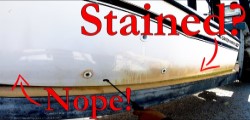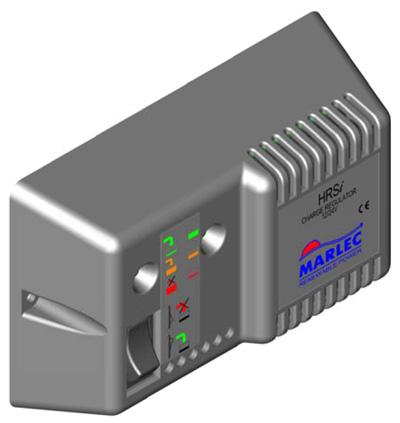Marlec's HRSi Charge Regulator once again leads the small wind turbine industry in technology and product features. The HRSi conveniently brings together a Rutland Windcharger voltage regulator with an input for up to 160Watts of photovoltaic panels in a single easy to install device. Multi-stage charge control delivers appropriate charge levels required to ensure your batteries get the maximum power they are able to retain and remain float charged.
 Technical Features
Technical Features
- Pulse Width Modulation (PWM) regulation is now more finely controlled using the latest programmable microcontrollers. PWM regulation monitors battery voltage to prevent overcharge. As peak voltages are reached the HRSi tapers the input charge from the wind & solar chargers gradually reducing input to float stage level. This feature gradually reduces the speed of the turbine to an eventual “idle” thus extending the working life of the windcharger. As the battery discharges the wind turbine responds by increasing speed to deliver more power. Solar power is also tapered in the same way.
- Intelligent Microcontroller system is programmed to deliver bulk and float phase charging. This feature ensures that batteries are optimally charged, especially when unattended.
- LED indicators keep the user informed about battery voltage levels and charging status.
- Manual shutdown switch allows the user to stop the wind & solar chargers from delivering power to the battery if required. The windcharger slows to a “idle” in this mode.
- Easy to connect terminals to interface windcharger, solar panels & battery connection.
- Temperature compensation automatically adjusts the settings of the regulator to take account of varying temperatures thus ensuring maximum charging efficiency in all conditions.
- Built in blocking diode avoids conflict with other charging sources to the same battery. (1)
- Automatic voltage detection for 12V or 24V systems (2)
- Built-in charge fuse protects the wiring circuit in the event of accidental reverse polarity connection.
- User voltage programme feature allows resetting of voltage cut in levels. Requires a variable DC power supply.
Notes:
1. Solar panels must be fitted with diodes
2. Batteries must be connected first for auto detection.
Technical Data
Input Capacity:
1 x Rutland 913 or FM910-3 Furlmatic or Rutland 503 Windcharger plus 160Watts peak rated solar panels maximum.
For connection to a single battery bank ( wired in parallel for 12 V and in series for 24 V ).
LED Display:
| Tri-Colour LED indicating battery voltage: | Tri-Colour LED indicating charging status: | ||
| Flashing Red | Battery Very Low | Green | Charging |
| Red | <12V (24V) | Amber | Charging & Regulating |
| Amber | >12V & <13V (>24V &<26V) | Red | Regulating |
| Green | >13V (26V) | ||
Dimensions:
Product 130 x 80 x 42 mm 185 g
Packaged 160 x 110 x 60 mm 255 g









